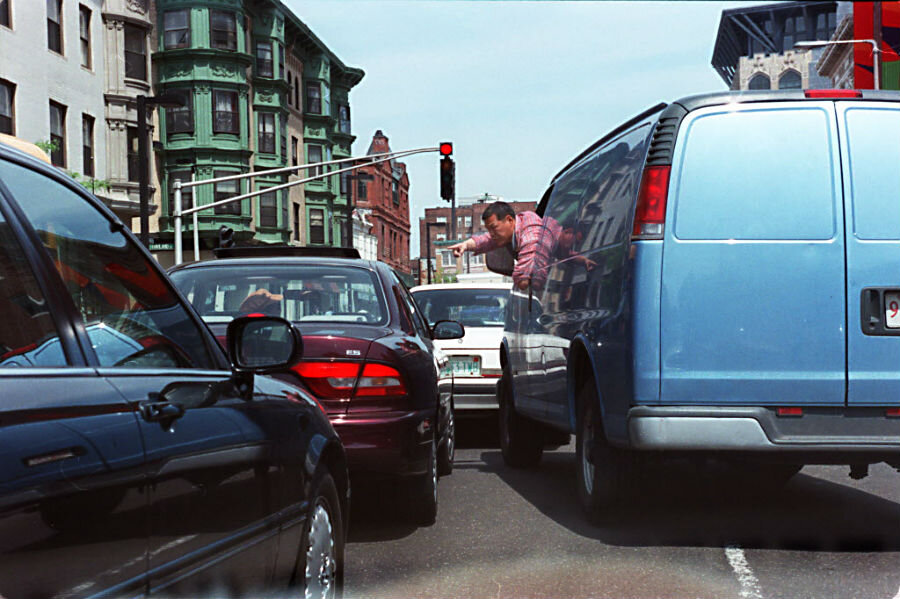Road rage is much more common than you think. What can you do about it?
Loading...
If you’ve ever been tempted to shout an obscenity, tailgate, or bump the car of the driver who just cut you off, you’re not alone, a study the AAA Foundation for Traffic Safety released Thursday found.
Nearly 80 percent of American drivers have expressed significant anger, aggression, or road rage at least once in the past year, according to AAA’s first-ever survey on road rage, conducted in 2014.
What the AAA's survey found is that, with more vehicles on the highway, and more traffic than ever, road rage appears to be on the rise. To curb it, experts encourage preventative driving, better enforcement, and, most of all, empathy for other drivers, whether they’re the ones yelling at you, or the ones you’re yelling at.
“Somebody might just be having a really bad day,” William Van Tassel, the manager of AAA’s Driver Training Operations, tells The Christian Science Monitor in a phone interview Wednesday. “It’s not about you. It’s about them. It’s somebody else’s bad day. Flow on by it,” he says, encouraging tolerance and forgiveness.
The term "road rage" was coined in 1988 in Los Angeles, the city of traffic jams, and freeways that turn into parking lots during the evening commute. Road rage, it seems, can take on many different forms. It has led to fistfights, crashes, and even murder. In its survey, AAA explored the most extreme expressions of road rage, as well as the less violent ones.
While nearly 80 percent of the drivers admitted to experiencing road rage in the past year, 3 percent (representative of 5.7 million drivers) said they purposefully bumped or rammed into another vehicle, the survey found. About half of drivers showed other, less aggressive expressions of the behavior: they purposefully tailgated or yelled at another driver. Of the 2,705 drivers surveyed, 12 percent said they cut off another vehicle; four percent said they left their vehicle to confront another driver.
There were 214 million licensed drivers in the United States in 2014, according to the Federal Highway Administration.
The survey is the first AAA ever conducted on the subject. Yet, it is line with one the road club AutoVantage has repeatedly conducted. In its 2014 survey, AutoVantage found road rage is on the rise, even though habits linked to aggressive driving aren’t. Compared to 2009, drivers observed less aggressive driving such as speeding, tailgating, or cutting someone off. But they also observed more horn honking, cursing, and obscene gestures.
Behavioral experts have attempted to pinpoint the underpinnings of road rage. They agree it is, in part, psychological. Leon James, a professor at the University of Hawaii who is an expert on road rage, portrays the aggressive behavior in more detail. It is a combination of nature and nurture, or, as he puts it, a reversion to “reptilian thinking” combined with “road rage nursery” we learn in the backseat of our parents’ cars, he told the Telegraph in 2006.
“People can switch from a rational human being to a lower mode,” said Dr. James. “If we perceive that we have been attacked by another driver then we flick into that mode, and that’s the beginning of a duel.”
He said we learn from our parents the definition of an “attack” by another driver and how we should subsequently react.
Steve Stradling, a professor emeritus of transport psychology at Napier University in Edinburgh, Scotland, suggests that road rage is triggered by three types of behaviors: impeding progress, reckless driving, and direct hostility.
One of the easiest ways to prevent eliciting the instinctual reactions of other drivers is prevention, says Dr. Van Tassel of AAA. Be courteous: Remember to switch your turn signal on and off, dim your high beams, leave plenty of space between you and other drivers, and don’t tailgate. If you upset another driver, don’t confront that driver or respond.
Besides encouraging drivers to avoid conflict, the survey’s authors urge public action campaigns or law enforcement to deter road rage. Different states categorize the crime of road rage under different violations. Most often, crimes associated with road rage fall under either aggressive driving or reckless driving.
If you became trapped in a fit of road rage yourself, you can remind yourself to stop engaging in the aggressive behavior. And if you can’t cool off when you get home, you could channel that frustration into a blog. That’s what Mike Shen did when he first moved to Los Angeles, and a woman viciously tailgated him on the freeway. Lacantdrive.com solicits pictures and written submissions from drivers, as well as rating the idiocy and aggressiveness of different driving maneuvers.







